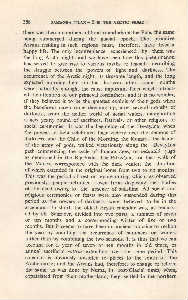Page 577 - Lokmanya Tilak Samagra (khand 2)
P. 577
358 SAMAGRA TILAK- 2 • THE AltCflC HOME
there was then a continent of land round about the Pole, the same
being submerged during the glacial epoch. The primitive
Aryans residing in such regions must, therefore, ' have lived a
happy life. The only inconvenience experienced by them was
the long Arctic night; and we have seen how this phenomenon
has served to give rise to various myths or legends describing
the struggle between the powers of light and darkness. The
occurrence of the Arctic night, its tiresome length, and the long
expected morning light on the horizon after some months
were, naturally enough, the most important facts which attract-
ed the attention of our primeval forefathers, and it is no wonder,
if they believed it to be the greatest exploit of their gods when
the beneficent dawn came dawning up, after several months of
darkness, from the nether world of aerial waters, inaugurating
a new yearly round of sacrifices, festivals, or other religious or
social ceremonies. It was the beginning of the Devayana, when
the powers of light celebrated their victory over the demons of
darkness, and the Child of the Morning, the Kumara, the leader
of the army of gods, walked victoriously along the Devayana
path commencing the cycle of human ages, or manushd yuga
as mentioned in the ~ig-Veda. The Pitriyana, or the walk of
the Manes, corresponded with the dark winter, the duration
of which extended in the original home from two to six months.
This was the period of rest or repose during which, as observed
previously, people refrained even from disposing the bodies
of the dead owing to the absence of sunshine. All social and
-religious ceremonies or feasts were also suspended during this
period as the powers of darkness were believed to be in the
ascendant. In short, the oldest Aryan calendar was, as remark-
ed by Dr. Schrader, divided into two parts, a summer of seven
or ten months and a corresponding winter of five or two
months. But it seems to have been an ancient practice to reckon
the year by counting the recurrence of summers or winters
rather than by combining the two seasons. It is thus that we can
account for a year of seven or ten months in old times, or
annual sacrificial sattras extending over the same period. This
calendar is obviously unsuited to places to the south of the
Arctic circle; and the Aryans had, therefore, to change or reform
the same, as was done by Numa, in post-Glacial times, when.
expatriated from their mother-land, they settled in the northern

